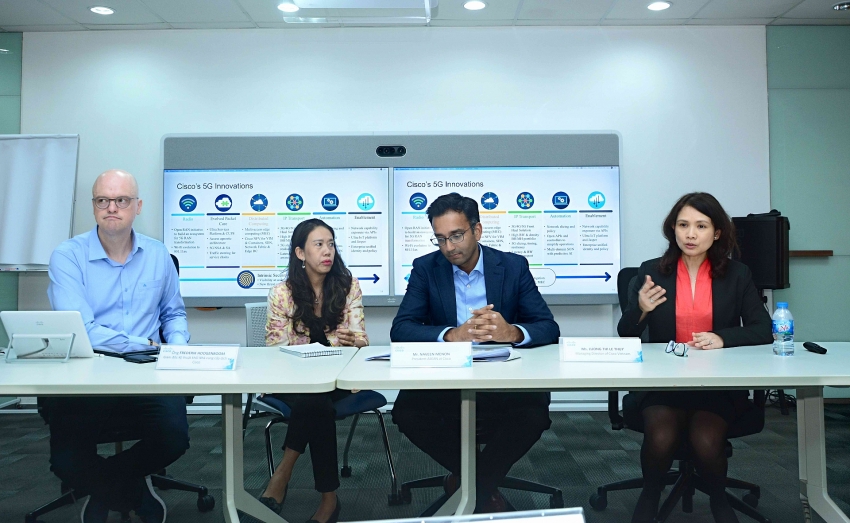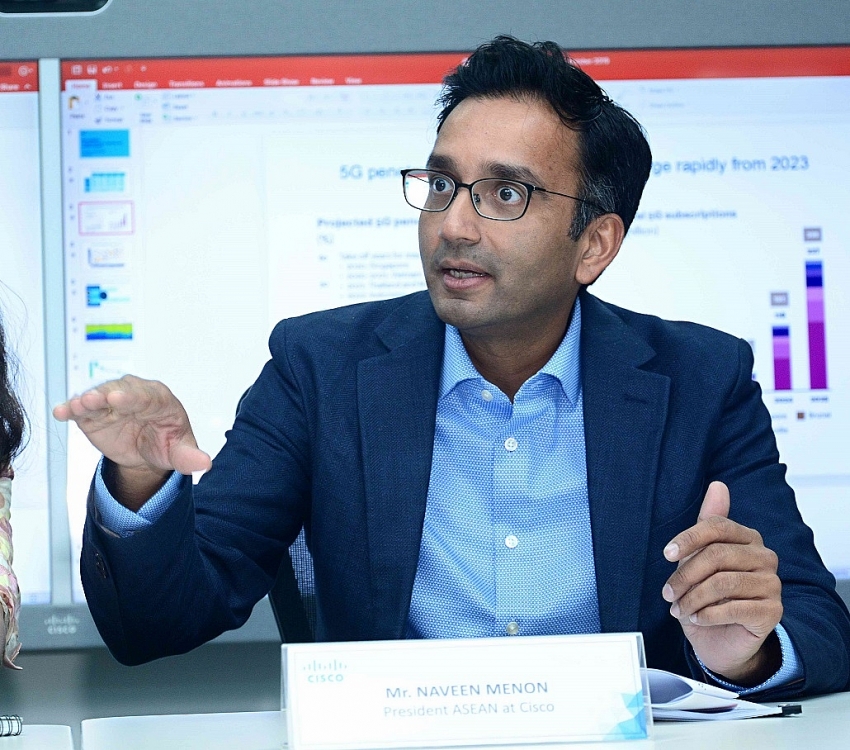5G could boost annual revenue of Vietnamese telcos by $300 million
 |
| The study commissioned by Cisco shows great potential in 5G technology |
The study, conducted by management consulting firm A.T. Kearney, highlights that 5G promises speeds up to 50 times faster, 10 times more responsiveness, and much lower power connectivity than 4G. This will be driven by a combination of three distinctive features – high throughput, ultra-low latency, and low power connectivity.
Speed, low latency, and enhanced connectivity will help telecom operators provide super-fast Internet connections that enable the streaming of high-definition videos, cloud gaming, and the delivery of interactive augmented and virtual reality (AR/VR)-powered content to consumers. It will also help to fast-track the commercialisation of several advanced use cases of 5G, including smart cities, Industry 4.0, large-scale Internet of Things (IoT) deployments, and more. This will enable telecom operators to increase revenues both from consumers as well as enterprise clients.
Titled, 5G in ASEAN: Reigniting growth in enterprise and consumer markets, the study states that initial growth of 5G adoption is expected to come from high-value customers and high-value devices, and subscriptions will start to scale as devices become more affordable.
As a result, the study expects 5G penetration to be around 25-40 per cent in major countries in the region by 2025.
 |
| Naveen Menon, president ASEAN at Cisco |
Naveen Menon, president, ASEAN at Cisco, said, “The expected rollout of 5G services comes at a perfect time for telecom operators. The usage of cellular data is growing rapidly as users consume an increasing amount of services and content on their personal devices. At the same time, enterprises are looking to leverage the Fourth Industrial Revolution, which is underpinned by AI, IoT, 3D printing, advanced robotics, and wearables, to boost growth. The successful adoption of these technologies is largely dependent on the underlying connectivity. This provides a huge opportunity for telecom operators to increase their presence in the enterprise market and sustain their long-term growth.”
Luong Thi Le Thuy, managing director for Vietnam at Cisco, said, “Countries like Vietnam have long benefited from having relatively low labour costs, especially in key sectors such as manufacturing. However, the advent of the Fourth Industrial Revolution will negate this advantage in the coming years. Vietnamese companies are aware of this and are looking to leverage related technologies to improve efficiency and sustain their future growth. The rollout of 5G services will play a key role in accelerating the digitalisation of businesses and bring substantial benefits to Vietnamese enterprises.”
As telecom operators get ready to roll out 5G services, they are likely to invest about $10 billion into the region’s 5G infrastructure by 2025.
Dharmesh Malhotra, managing director ASEAN, service provider, at Cisco, said: “The rollout of 5G services will require substantial investments in technology to modernise underlying networks. In the ASEAN, telecom operators are likely to continue to invest in upgrading their 4G networks and build 5G capabilities in a phased manner. This will allow 4G and 5G to operate simultaneously and help operators manage their capex and ROI in a sustainable manner. Cisco is partnering with network operators in their journey to 5G rollout and is already engaged with customers in the ASEAN on 5G transformation.”
 |
| Mr. Frederik Hoogenboom, Director Engineering & Technology Service Provider Sales, ASEAN |
The study highlights that to unlock this potential, the region needs to address some key challenges.
Foremost among these is the slow availability of the spectrum for 5G services and the resulting suboptimal network rollout. 5G will be deployed across multiple bands, with three bands likely to be important globally in the near-term: low band (700 MHz), mid-band (3.5 to 4.2 GHz), and high-band on mmWave spectrum (24-28 GHz). In the ASEAN, many of these bands are already being used to provide other services. Low band is being used for FTA TV, and mid-band is being used for satellite services. Although mmWave bands are available, deployment will need to be combined with low band spectrum to enable an economically viable coverage of suburban and rural areas as well as in-building access.
In addition, operators will need to carefully construct their 5G product and pricing portfolios and migrate consumers to the high-speed network. Consumers are excited about 5G and are willing to pay for better quality, unlike 3G and 4G technology. It would be fatal for operators to engage in a price war just to attract a higher number of subscribers in the hope they can charge them more at a later stage.
On the enterprise side, operators will need to build new capabilities and bundle enhanced connectivity with solutions and applications to help customers understand, implement, and scale up value-enhancing use cases. They will also have to contend with a new set of competitors that provide private networks to enterprises.
Hari Venkataramani, partner at A.T. Kearney and a lead author of the report, said: “The overall potential of 5G rollout in the ASEAN is substantial. However, to live up to the full potential, the region will need to address the main challenges. This will require a co-ordinated effort from all stakeholders – regulators, operators, and enterprises. Given the ecosystem challenges and the large value at stake, regulators will play a central role. Among the key issues that regulators would need to take the lead on are: ensuring near-term spectrum availability, fostering infrastructure sharing, and nurturing the development of national cybersecurity capabilities across the region.”
What the stars mean:
★ Poor ★ ★ Promising ★★★ Good ★★★★ Very good ★★★★★ Exceptional
Related Contents
Latest News
More News
- Human-centred governance seen as key to AI development (December 19, 2025 | 18:19)
- Top 10 notable events of Vietnam’s industry and trade sector in 2025 (December 19, 2025 | 14:00)
- Tungsten surges to 12-year high as world enters a new 'black gold' race (December 18, 2025 | 17:27)
- Vietnam’s coffee exports set new record despite price pressures (December 18, 2025 | 17:13)
- Garment and textile sector seeks new growth after volatile year (December 18, 2025 | 17:01)
- VinSpeed and Siemens strengthen cooperation for high-speed rail development (December 18, 2025 | 16:53)
- High-tech adoption for TH true MILK (December 18, 2025 | 13:39)
- Takeda supports health resilience amid climate change challenges (December 18, 2025 | 12:39)
- Mondelez Kinh Do - a chapter of purpose-led leadership in Vietnam (December 18, 2025 | 09:44)
- VNPAY services receive the highest-level PCI DSS international security certificates for six consecutive years (December 17, 2025 | 23:47)

 Tag:
Tag:



























 Mobile Version
Mobile Version